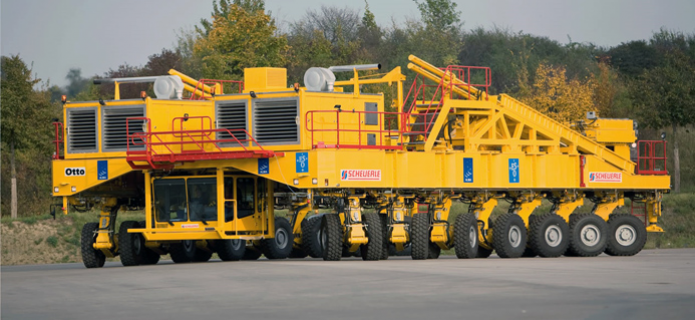A colossus gets its name
With a size of 10 metres wide, 20 metres long and 6 metres high, the ALMA antenna transporter is a real colossus
The transporter was named 'Otto' in honour of Otto Rettenmaier, the owner of the Scheuerlecompany. "The rather unusual move to name a vehicle is a recognition of the remarkable achievement these unique machines represent," said Hans Rykaczewski, the European ALMA Project Manager. "Their sizes alone would justify using superlatives to describe them. But they are also outstanding as they will operate at 5000 metres altitude, where the air is rare, and they have to be able to place 115-ton antennas with a precision of a few millimetres," he added.
"The ALMA antenna transporters are the proof of the excellence of our staff and of our ability to build heavy vehicles that are at the limits of the possible," said Otto Rettenmaier. "Never in the history of our company have we had to comply with such exceptional requirements on material and techniques as we had to do with these machines. We are proud as a company to have been able to contribute with such an exceptional piece of technology for astronomical research."
The ALMA Project is a giant, international observatory currently in construction on the high-altitude Chajnantor site in Chile, which will be composed initially of 66 high-precision telescopes, operating at wavelengths of 0.3 to 9.6 mm. The ALMA antennas will be electronically combined and provide astronomical observations which are equivalent to a single large telescope of tremendous size and resolution.
The 66 antennas of the array can be placed on 192 different pads, covering antenna configurations as compact as 150 metres to as wide as 15 kilometres. Changing the relative positions of the antennas and thus also the configuration of the array allows for different observing modes, comparable to using a zoom lens on a camera.
Given their important functions, both for the scientific work and in transporting high-tech antennas with the required care, the vehicles must live up to very demanding operational requirements. To address these, Scheuerle has developed and built two very special transporters. Building heavy vehicles able to transport with great precision 115-ton antennas is not a problem per se for this company, which specialises in building huge transporters. The problem however was to produce a vehicle able to operate at such a high altitude, where the two engines will lose about half of their power (compared to sea level) because of the reduced oxygen content of the air. With their two 500 kW diesel engines (nearly as much as two Formula 1 engines), the ALMA transporters will be able to move at the speed of 20 km/h when empty and 12 km/h when loaded with an antenna.
Notwithstanding its impressive dimensions, the transporter can be manoeuvred by a single operator, the precise positioning being made possible by a hydrostatic system while the electronic 28-wheel drive allows very precise motions.
"When completed in 2012, ALMA will be the largest and most capable imaging array of telescopes in the world," said Massimo Tarenghi, the ALMA Director. "The ALMA antenna transporters, which are unique technological jewels, beautifully illustrate how we are actively progressing towards this goal."
More Information
ALMA will be able to probe the Universe at millimetre and submillimetre wavelengths with unprecedented sensitivity and resolution, with an accuracy up to ten times better than the Hubble Space Telescope, and complementing images made with ESO's Very Large Telescope Interferometer.
ALMA will be the forefront instrument for studying the cool universe - the relic radiation of the Big Bang, and the molecular gas and dust that constitute the very building blocks of stars, planetary systems, galaxies, and life itself.
Because ALMA will observe in the millimetre and submillimetre wavelengths the atmosphere above the telescope must be transparent. This requires a site that is high and dry. ALMA will thus be installed at the 5000m high plateau of Chajnantor in the Atacama Desert of Chile, the world's driest area - the next best location to outer space for these high-accuracy astronomical observations.
